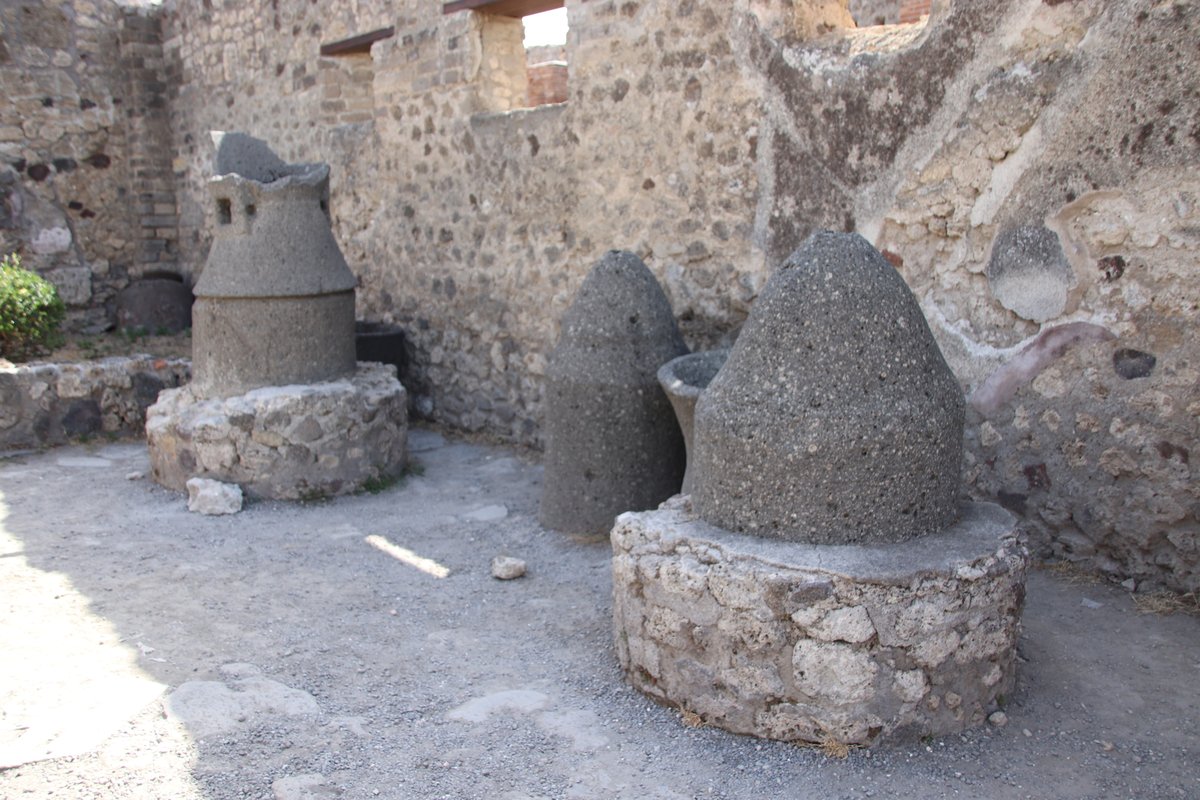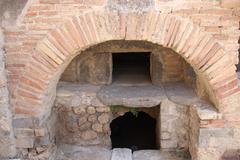
Bakery IX.1.3 in Pompeii: Visiting Hours, Tickets, and Travel Guide
Date: 14/06/2025
Introduction: Discovering Bakery IX.1.3 and Its Historical Significance
Pompeii, the ancient Roman city frozen in time by the eruption of Mount Vesuvius in 79 CE, remains a source of fascination for historians, archaeologists, and travelers. Among its many archaeological wonders, Bakery IX.1.3 in Regio IX stands out as an exceptional site, offering insight into the technological, social, and economic fabric of the ancient city. Far more than a simple place for baking bread, this bakery provides a microcosmic view of Pompeii’s economy, labor practices, and daily life, while also reflecting the complexities of Roman society.
Located along the busy Via di Nola, Bakery IX.1.3 occupied an entire insula and played a crucial role in feeding Pompeii’s population. Its preserved millstones, brick oven, and ancillary spaces reveal the sophistication of Roman baking technology and the industrial scale of food production. Through the lens of this bakery, visitors can explore themes of technological innovation, social hierarchy, enslaved labor, and religious practices in antiquity (The Art Newspaper; World History Encyclopedia; Pompei.it).
This guide provides a comprehensive overview of Bakery IX.1.3—including its origins, architectural details, cultural context, and practical visitor information—to help you plan an enriching and informed visit.
Table of Contents
- Introduction
- Origins and Urban Context
- Architectural Features and Equipment
- Bread Production and Distribution
- Labor Structure and Social Hierarchies
- Religious and Decorative Elements
- Archaeological Discoveries and Preservation
- Visiting Bakery IX.1.3: Practical Information
- Frequently Asked Questions (FAQs)
- Conclusion
- References and Further Reading
Origins and Urban Context of Bakery IX.1.3
Bakery IX.1.3 is situated in the densely populated Regio IX, occupying a prime location on Via di Nola—one of Pompeii’s main thoroughfares. Its position facilitated the efficient movement of goods and access to raw materials. Archaeological findings suggest that bakeries in Pompeii were often integrated into residential complexes, exemplifying the blending of domestic and commercial functions in Roman urban settings (The Art Newspaper; World History Encyclopedia).
Architectural Features and Equipment
Milling Room
The heart of Bakery IX.1.3 is its milling room, paved with volcanic basalt slabs marked by semicircular grooves—worn smooth by years of use—which directed the movement of donkeys and enslaved workers operating the heavy millstones (Euronews). Typically, four large volcanic lava millstones were powered in tandem, demonstrating the scale and efficiency of ancient bread production.
Oven and Baking Area
Adjacent to the milling room is a large domed oven constructed from brick and volcanic stone. This structure retained heat effectively and included a wide mouth for loading bread, as well as a flue for smoke ventilation. Work surfaces for kneading and shaping dough, though less well-preserved, were essential components of the bakery’s operation (Pompeii in Pictures).
Storage and Ancillary Spaces
Amphorae and storage rooms near the production areas held grain, flour, and finished bread. A stable connected to the milling room housed the donkeys that powered the millstones, with high barred windows and restricted access underscoring the control exerted over both animals and workers (Pompeii Archaeological Park).
Residential Quarters
The residential section, partially renovated at the time of the eruption, displayed elaborate Fourth Style frescoes—evidence of the owner’s wealth and social standing. A clear division between the owner’s quarters and the bakery’s production area highlights the social divide within the complex (Euronews).
Bread Production and Distribution
Bread was fundamental to the Pompeian diet, and bakeries like IX.1.3 were essential urban institutions. At least 35 bakeries supplied Pompeii’s residents, with some—such as IX.1.3—operating on a wholesale scale to supply vendors and retailers across the city (World History Encyclopedia). The production process included grinding grain into flour using the millstones, kneading dough, and baking loaves daily. The bakery’s design enabled efficient mass production, storage, and distribution.
Labor Structure and Social Hierarchies
Bakery IX.1.3 is often described as a “bakery-prison” due to evidence of harsh conditions for enslaved laborers. Cramped milling rooms, barred windows, and a single exit—all leading through the owner’s atrium—restricted movement and maintained control (The Art Newspaper; Smithsonian Magazine). Floor indentations show where blindfolded donkeys and enslaved individuals walked endless circles to power the millstones. Recent excavations have uncovered the remains of victims of the eruption inside the bakery, offering a sobering glimpse into the vulnerability and exploitation of marginalized groups (Euronews).
Religious and Decorative Elements
Despite its utilitarian function, Bakery IX.1.3 featured religious and decorative motifs. A pilaster opposite the oven displayed a painting of the Genius spirit pouring a libation next to a serpent—typical of Pompeian lararia (household shrines) (Pompeii in Pictures). Additional decorative features include painted niches with deities and protective symbols, such as phallic engravings and inscriptions wishing happiness, which reflect Roman beliefs in household luck and prosperity (Pompei.it).
Archaeological Discoveries and Preservation
Bakery IX.1.3 has benefited from recent conservation efforts under the Great Pompeii Project. Ongoing excavations have revealed not just the bakery’s layout and equipment, but also household items, frescoes, and food remnants—including depictions of bread and pizza-like dishes—that enrich our understanding of Pompeii’s culinary culture (The Art Newspaper). The exceptional preservation of the site offers a rare, tangible link to the past.
Visiting Bakery IX.1.3: Practical Information
Visiting Hours
Bakery IX.1.3 is accessible during standard Pompeii Archaeological Park hours:
- April–October: 9:00 AM to 7:00 PM (last entry at 6:00 PM)
- November–March: 9:00 AM to 5:00 PM (last entry at 3:30 PM)
Check the official website for any updates or seasonal variations.
Tickets
Entry to Bakery IX.1.3 is included with the general Pompeii site ticket.
- Adults: €16
- EU citizens (18–25): Reduced rate
- Children under 18: Free
Tickets can be purchased online or onsite. Combined tickets and guided tour options are available.
Accessibility
The bakery features uneven stone floors and narrow passages, which may limit accessibility for visitors with mobility impairments. Wheelchair access is available to many parts of the park, but assistance may be required in certain areas.
Travel Tips
- Wear sturdy, comfortable shoes suitable for uneven terrain.
- Bring water, especially during summer visits.
- Early mornings or weekdays are best for avoiding crowds and heat.
- Guided tours enhance understanding of the bakery’s history and context.
Nearby Attractions
After exploring Bakery IX.1.3, consider visiting these nearby sites within Pompeii:
- The Forum
- Amphitheater
- House of the Vettii
- Villa of the Mysteries
Guided Tours and Special Events
Expert-led guided tours focusing on food production, daily life, and urban organization in Pompeii often include Bakery IX.1.3. Seasonal events and temporary exhibitions may also highlight new discoveries.
Visual Gallery



Frequently Asked Questions (FAQs)
Q: What are the visiting hours for Bakery IX.1.3?
A: The bakery is open during Pompeii’s regular hours (generally 9:00 AM–7:00 PM in summer; 9:00 AM–5:00 PM in winter).
Q: Do I need a separate ticket for Bakery IX.1.3?
A: No, entry is included in the general Pompeii Archaeological Park ticket.
Q: Is the bakery accessible for visitors with disabilities?
A: Some terrain is uneven and narrow; check accessibility information in advance.
Q: Are guided tours available?
A: Yes, many guided tours cover Bakery IX.1.3 and offer valuable historical context.
Q: Can I take photos inside the bakery?
A: Photography is generally allowed for personal use, but flash and tripods may be restricted.
Conclusion
Bakery IX.1.3 is a window into the technological innovation, social complexity, and daily rhythms of ancient Pompeii. Its preservation allows contemporary visitors to experience firsthand the realities of Roman urban life, from mass food production to the harsh conditions faced by enslaved workers. Combining rich archaeological details with practical visitor information, a visit to Bakery IX.1.3 is both an educational and moving experience—connecting us to the enduring legacy of Roman civilization.
For the latest updates, official guides, and immersive experiences, download the Audiala app and explore our additional resources. Plan your journey to Pompeii and step into history at Bakery IX.1.3.
References and Further Reading
- The Art Newspaper - Recent Excavations
- World History Encyclopedia - Bakery of Popidius Priscus
- Pompei.it - Breadmaking
- Euronews - Pompeii Archaeologists Uncover Bakery
- Smithsonian Magazine - Brutal Bakery Prison at Pompeii
- Pompeii Archaeological Park - Official Site
- Pompeii in Pictures - Bakery IX.1.3































































